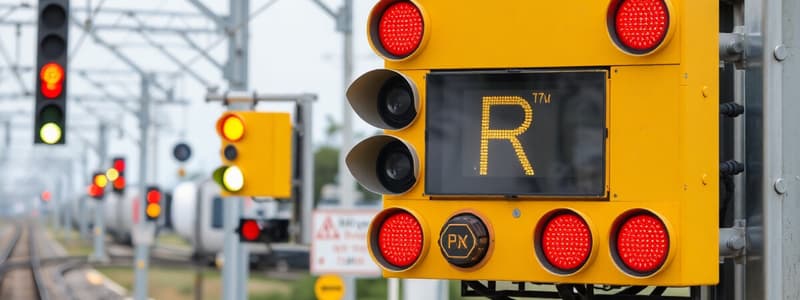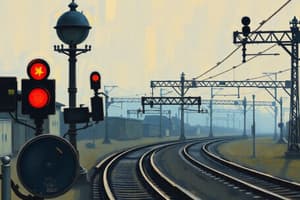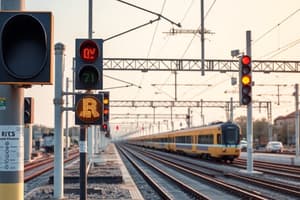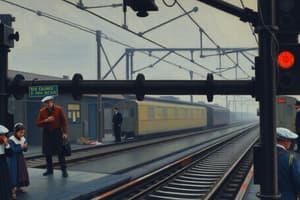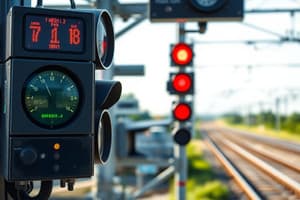Podcast
Questions and Answers
What characterizes Manual Stop Signals?
What characterizes Manual Stop Signals?
- They can operate without a fixed signal.
- They can only function in an automatic mode.
- They require manual control each time they are taken 'OFF'. (correct)
- They can be operated automatically without manual intervention.
Which statement is true regarding Semi-Automatic Stop Signals?
Which statement is true regarding Semi-Automatic Stop Signals?
- They do not use track circuit controls.
- They are incapable of manual operation.
- They can be operated both automatically and manually as required. (correct)
- They can only function as Automatic Stop Signals.
What happens to Manual Stop Signals when the section ahead is occupied?
What happens to Manual Stop Signals when the section ahead is occupied?
- They signal the operator to proceed without stopping.
- They remain in the 'OFF' position.
- They need to be manually reset to 'ON'.
- They automatically switch to the 'ON' position. (correct)
What is the function of the control provided for Semi-Automatic Stop Signals?
What is the function of the control provided for Semi-Automatic Stop Signals?
In a single line operation, what must be established according to GR 9.03?
In a single line operation, what must be established according to GR 9.03?
What is the primary function of an Automatic Block System in train signalling?
What is the primary function of an Automatic Block System in train signalling?
What determines the 'ON' position of a Stop Signal in an Automatic Signalling section?
What determines the 'ON' position of a Stop Signal in an Automatic Signalling section?
What is the minimum safe distance a line must be clear for an Automatic Stop Signal to switch to 'OFF' position?
What is the minimum safe distance a line must be clear for an Automatic Stop Signal to switch to 'OFF' position?
When must an Automatic Stop Signal remain in the 'ON' position?
When must an Automatic Stop Signal remain in the 'ON' position?
What prohibits an Automatic signal from being switched to 'OFF' position?
What prohibits an Automatic signal from being switched to 'OFF' position?
Which aspect of signal spacing is critical to avoid serious repercussions during signalling failures?
Which aspect of signal spacing is critical to avoid serious repercussions during signalling failures?
How does the spacing of signals relate to a train's emergency braking distance?
How does the spacing of signals relate to a train's emergency braking distance?
What regulates the speed of a train when the signal spacing is less than the emergency braking distance?
What regulates the speed of a train when the signal spacing is less than the emergency braking distance?
What must Automatic Stop Signals exhibit when positioned against the direction of traffic?
What must Automatic Stop Signals exhibit when positioned against the direction of traffic?
Which of the following is true regarding the provision of DC Track circuits in block sections?
Which of the following is true regarding the provision of DC Track circuits in block sections?
What feature should the design of Axle Counters between adjacent stations include?
What feature should the design of Axle Counters between adjacent stations include?
What type of indicator should be provided for Automatic Signalling on a Single Line?
What type of indicator should be provided for Automatic Signalling on a Single Line?
Which of the following describes the characteristics of markers for Automatic Stop Signals?
Which of the following describes the characteristics of markers for Automatic Stop Signals?
What is a key requirement for track circuits or axle counters on passenger running lines?
What is a key requirement for track circuits or axle counters on passenger running lines?
What mechanism should be implemented to improve availability in Track circuits or Axle Counters?
What mechanism should be implemented to improve availability in Track circuits or Axle Counters?
What is the purpose of media diversity in relation to Axle Counters?
What is the purpose of media diversity in relation to Axle Counters?
What should occur if a signal that must show a red aspect fails to do so?
What should occur if a signal that must show a red aspect fails to do so?
What principle must all fail-safe circuits operate on?
What principle must all fail-safe circuits operate on?
Under what condition can an automatic signal display the 'OFF' position?
Under what condition can an automatic signal display the 'OFF' position?
What must be proven before the 'A' marker of a Semi Automatic Signal lights up?
What must be proven before the 'A' marker of a Semi Automatic Signal lights up?
What happens if the lamp of the displayed aspect fails?
What happens if the lamp of the displayed aspect fails?
Which component should control the aspects of an automatic signal?
Which component should control the aspects of an automatic signal?
What is required for the 'AG' marker to light up when conditions are met?
What is required for the 'AG' marker to light up when conditions are met?
What information should be visible at the station regarding automatic signalling?
What information should be visible at the station regarding automatic signalling?
What is required before establishing the direction of traffic on a single line using the Automatic Block System?
What is required before establishing the direction of traffic on a single line using the Automatic Block System?
What happens to the Automatic Stop signal after the direction of traffic has been established?
What happens to the Automatic Stop signal after the direction of traffic has been established?
When can 'Line Clear' be obtained according to the Automatic Block System requirements?
When can 'Line Clear' be obtained according to the Automatic Block System requirements?
How can the direction of traffic be established in the Automatic Block System?
How can the direction of traffic be established in the Automatic Block System?
What must be ensured in the area between the two crossing stations before changing direction?
What must be ensured in the area between the two crossing stations before changing direction?
What is the minimum adequate distance that must be clear for Line Clear to be obtained?
What is the minimum adequate distance that must be clear for Line Clear to be obtained?
What must happen to all Stop signals against the direction of traffic in the Automatic Block System?
What must happen to all Stop signals against the direction of traffic in the Automatic Block System?
What is true regarding the division of the line between two adjacent block stations?
What is true regarding the division of the line between two adjacent block stations?
What must happen to the ‘A’ marker of the Advanced Starter Signal when the modified semi-automatic stop signal is activated?
What must happen to the ‘A’ marker of the Advanced Starter Signal when the modified semi-automatic stop signal is activated?
Under what conditions does the mid-section modified semi-automatic stop signal work normally?
Under what conditions does the mid-section modified semi-automatic stop signal work normally?
How many trains can be signaled simultaneously on either side of a mid-section modified semi-automatic stop signal?
How many trains can be signaled simultaneously on either side of a mid-section modified semi-automatic stop signal?
What color scheme is used for painting the mid-section modified automatic signal?
What color scheme is used for painting the mid-section modified automatic signal?
What provides indication of the signal's operational mode to the station masters?
What provides indication of the signal's operational mode to the station masters?
What is the purpose of the interlocking system during mid-section modified automatic signalling?
What is the purpose of the interlocking system during mid-section modified automatic signalling?
What is required for the modified semi-automatic stop signal to function during abnormal conditions?
What is required for the modified semi-automatic stop signal to function during abnormal conditions?
What aspect does the mid-section modified automatic signal depict when it is set to 'OFF'?
What aspect does the mid-section modified automatic signal depict when it is set to 'OFF'?
Flashcards
Automatic Block System
Automatic Block System
A system that automatically controls train movement using stop signals triggered by train passage.
Automatic Stop Signal
Automatic Stop Signal
A color-light signal that automatically regulates train entry into a signalling section, controlled by train passage.
Signalling section
Signalling section
A portion of a railway line between two adjacent crossing stations, controlled by signals to regulate train entry.
Clear Line Distance
Clear Line Distance
Signup and view all the flashcards
Automatic Signal Spacing
Automatic Signal Spacing
Signup and view all the flashcards
Emergency Braking Distance
Emergency Braking Distance
Signup and view all the flashcards
Signal Aspect Spacing
Signal Aspect Spacing
Signup and view all the flashcards
120/180 Metre Rule
120/180 Metre Rule
Signup and view all the flashcards
Manual Stop Signal
Manual Stop Signal
Signup and view all the flashcards
Semi-Automatic Stop Signal
Semi-Automatic Stop Signal
Signup and view all the flashcards
Single-Line Automatic Block System
Single-Line Automatic Block System
Signup and view all the flashcards
GR 9.03
GR 9.03
Signup and view all the flashcards
Automatic Block System on Single Line
Automatic Block System on Single Line
Signup and view all the flashcards
Line Clear on Single Line
Line Clear on Single Line
Signup and view all the flashcards
Direction of Traffic on Single Line
Direction of Traffic on Single Line
Signup and view all the flashcards
Automatic Stop Signal on Single Line
Automatic Stop Signal on Single Line
Signup and view all the flashcards
Adequate Distance Beyond Stop Signal
Adequate Distance Beyond Stop Signal
Signup and view all the flashcards
Establishing Direction of Traffic for Automatic Stop Signals
Establishing Direction of Traffic for Automatic Stop Signals
Signup and view all the flashcards
Overlap in Direction of Traffic
Overlap in Direction of Traffic
Signup and view all the flashcards
Control to Establish Traffic Direction for Automatic Stop Signals
Control to Establish Traffic Direction for Automatic Stop Signals
Signup and view all the flashcards
Approach locked
Approach locked
Signup and view all the flashcards
Track Circuit
Track Circuit
Signup and view all the flashcards
Axle Counter
Axle Counter
Signup and view all the flashcards
Overlap Track Circuit
Overlap Track Circuit
Signup and view all the flashcards
Redundancy in Track Circuits/Axle Counters
Redundancy in Track Circuits/Axle Counters
Signup and view all the flashcards
Media Diversity for Axle Counters
Media Diversity for Axle Counters
Signup and view all the flashcards
Track Indicator
Track Indicator
Signup and view all the flashcards
Fail-Safe Circuits
Fail-Safe Circuits
Signup and view all the flashcards
Double Cutting Arrangements
Double Cutting Arrangements
Signup and view all the flashcards
Restrictive Aspect
Restrictive Aspect
Signup and view all the flashcards
Semi-Automatic Signal
Semi-Automatic Signal
Signup and view all the flashcards
A Marker
A Marker
Signup and view all the flashcards
AG Marker
AG Marker
Signup and view all the flashcards
Points and Back-locking
Points and Back-locking
Signup and view all the flashcards
Information Visibility at Station
Information Visibility at Station
Signup and view all the flashcards
Modified Semi-Automatic Signal
Modified Semi-Automatic Signal
Signup and view all the flashcards
Mid-Section Modified Semi-Automatic Signal
Mid-Section Modified Semi-Automatic Signal
Signup and view all the flashcards
Extinguished 'A' Marker
Extinguished 'A' Marker
Signup and view all the flashcards
Signal Aspect
Signal Aspect
Signup and view all the flashcards
Gate Signal Conversion
Gate Signal Conversion
Signup and view all the flashcards
Normal vs. Modified Modes
Normal vs. Modified Modes
Signup and view all the flashcards
Blue and White Strips
Blue and White Strips
Signup and view all the flashcards
Station Masters' Indication
Station Masters' Indication
Signup and view all the flashcards
Study Notes
Automatic Block Signalling - General
- Automatic Block Systems control train movement using stop signals. These signals automatically operate based on train passage.
- Automatic stop signals are not manually operated but are controlled automatically as a train enters, goes through, and leaves a section.
- Sections between stations are divided into smaller signalling sections.
- Entry into each section is regulated by manual, automatic, or semi-automatic stop signals.
- Signals must switch to the 'ON' position when a train enters a section and remain 'ON' until the train passes beyond the next signal and a safe distance.
- Signals will only switch to the 'OFF' position when the section is clear, not just to the next signal, but a predetermined distance beyond it. This distance varies depending on whether the next signal is manual, semi-automatic, or automatic.
- Signal spacing is crucial to ensure adequate braking distances for trains, preventing problems during failures or accidents.
- Appropriate distances must be considered between signals to prevent issues with train braking distances.
- Manual stop signals and semi-automatic stop signals require manual control to switch from 'On' to 'Off'.
Special Requirements for Single Line
- Single-line automatic block systems require line-clear procedures and established traffic directions, as defined by GR 9.03.
- Continuous track circuits or axle counters are mandatory.
- Traffic direction is established only after line-clear confirmation from the previous block station.
- A train can only travel to the next block station after the direction of traffic is established.
- Line clearance must verify not just the next signal, but also sufficient distance beyond for safety.
- Signals prohibiting traffic in the opposite direction must remain 'ON'.
- The minimum distance beyond the next signal must be at least 180m if the next is manual or semi-automatic.
Train Detection and Markers
- Train detection systems (track circuits/axle counters) are used to divide the line into sections for automatic signalling operation.
- Track circuits/axle counters are required on passenger and other lines connecting stations in automatic sections, reducing dead zones.
- Automatic stop signals have identifiable markers (white disc with letter ‘A’ in black).
- Semi-automatic signals also have 'A' markers (illuminated white ‘A’ on a black background) when operating as automatic signals and additional 'AG' markers when needed to control gate signals or points.
- A control system is used to establish direction of traffic and ensure conflicting signal operation cannot happen.
- LED signals are recommended.
- All external circuits should be able to be shut down for safety reasons.
Maintenance and Modifications
- Regular maintenance is required for LED signals, marker lights, track circuits, interlocking equipment, and axle counters.
- Procedures for track renewal, equipment failures, or other aspects should be in place.
- Under certain instructions, some automatic stop signals between stations can be modified for semi-automatic operation.
- Modifying signals for semi-automatic use must address safety concerns related to train movements in abnormal conditions like fog.
Studying That Suits You
Use AI to generate personalized quizzes and flashcards to suit your learning preferences.
